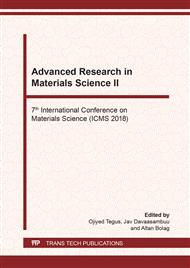[1]
A.Tamilvanan, B.Kulendran, K. Ponappa, B. Madhan Kumar, Copper Nanoparticles: Synthetic Strategies, Properties and Multifunctional Application, Int. J. of Nanosci. 13(02) (2014).
DOI: 10.1142/s0219581x14300016
Google Scholar
[2]
R.Manimaran, K. Palaniradja, N. Alagumurthi, S.Sendhilnathan, J. Hussain, Preparation and characterization of copper oxide nanofluid for heat transfer applications, Appl. Nanosci. 4 (2014) 163–167.
DOI: 10.1007/s13204-012-0184-7
Google Scholar
[3]
I. Chepkasov, Y. Gafner, S. Gafner, S. Bardakhanov, Condensation of Cu nanoparticles from the gas phase, The Physics of Metals and Metallography 117 (2016) 1003–1012.
DOI: 10.1134/s0031918x16080020
Google Scholar
[4]
A.P. Zavjalov, K.V. Zobov, V.V. Syzrantsev, S.P. Bardakhanov, I.K. Chakin, Synthesis of copper nanopowders using electron-beam evaporation at atmospheric pressure of inert gas, Nanotechnologies in Russia 9 (2014) 660–666.
DOI: 10.1134/s1995078014060196
Google Scholar
[5]
N. Yumozhapova, A. Nomoev, Y. Gafner, Computer Modeling of the Formation Process of Core-Shell Nanoparticles Cu@Si, Solid State Phenomena 271 (2018) 47-50.
DOI: 10.4028/www.scientific.net/ssp.271.47
Google Scholar
[6]
S. Bardakhanov, A. Nomoev, M. Schreiber, A. Radnaev, R. Salimov , K. Zobov, A. Zavjalov and E. Khartaeva, Chanel Structures Formed in Copper Ingots upon Melting and Evaporation by a Higt-Power Election Beam, Metals 5 (2015) 428-438.
DOI: 10.3390/met5010428
Google Scholar
[7]
L. D. Marks, L. Peng, Nanoparticle shape, thermodynamics and kinetics, J. Phys.: Condens, Matter, 28, (2016).
Google Scholar
[8]
Large-scale Atomic/Molecular Massively Parallel Simulator, LAMMPS, available at: http://lammps.sandia.gov.
DOI: 10.21236/ada623365
Google Scholar
[9]
S. M. Foiles, M. Baskes and M. S. Daw, Embedded-atom-method functions for the fcc metals Cu, Ag, Au, Ni, Pd, Pt, and their alloys, Phys. Rev. B 33, 7983 (1986).
DOI: 10.1103/physrevb.33.7983
Google Scholar
[10]
J. D. Honeycutt, H. C. Andersen, Molecular dynamics study of melting and freezing of small Lennard-Jones clusters, J.Phys. Chem. 91, 4950 (1987) 4950–4963.
DOI: 10.1021/j100303a014
Google Scholar
[11]
H. Tuzuki, P. S. Branicio, J. P. Rino, Structural characterization of deformed crystals by analysis of common atomic neighborhood, Comput. Phys. Commun. 177 (2007) 518-523.
DOI: 10.1016/j.cpc.2007.05.018
Google Scholar
[12]
D. Faken, H. Jonsson, Systematic analysis of local atomic structure combined with 3D computer graphics, Comput. Mater. Sci. 2 (1994) 279-286.
DOI: 10.1016/0927-0256(94)90109-0
Google Scholar


